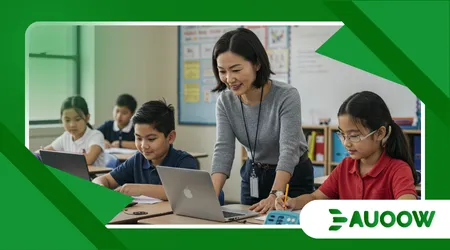How Teachers Can Use Tech to Support Neurodiverse Learners

In 2025, using tech to support neurodiverse learners transforms classrooms into inclusive havens.
Neurodiversity encompassing autism, ADHD, dyslexia, and more demands tailored educational approaches.
Technology, when wielded thoughtfully, bridges gaps, empowering students with diverse cognitive needs to thrive.
This article explores how educators can harness digital tools to foster equity, engagement, and success. From adaptive platforms to immersive realities, the possibilities are vast.
Why settle for one-size-fits-all when tech can personalize learning? Let’s dive into practical, evidence-based strategies that make inclusion a reality.
Understanding Neurodiversity in the Classroom
Neurodiversity celebrates the spectrum of human cognition. Students with autism may excel in pattern recognition but struggle with social cues.
Those with ADHD often face challenges sustaining focus, while dyslexic learners may find reading arduous.
A 2024 study by the National Center for Learning Disabilities found 1 in 5 students has a learning or attention issue, underscoring the need for inclusive strategies.
Teachers must recognize these differences as variations, not deficits.
Embracing this mindset shifts pedagogy. Technology amplifies this shift, offering tools to meet diverse needs.
For instance, a student with dyslexia might use text-to-speech software to access texts.
++ The Hidden Biases in Standardized Testing for Students with Disabilities
Using tech to support neurodiverse learners ensures no one is left behind. Educators become facilitators of potential, not gatekeepers of uniformity.
Classrooms are microcosms of society. Ignoring neurodiversity risks alienating students.
Tech offers solutions where traditional methods falter, creating environments where every learner feels valued.
By understanding neurodiversity, teachers lay the foundation for meaningful tech integration.

Adaptive Learning Platforms: Personalizing Education
Adaptive platforms like Squirrel AI adjust content to a student’s pace. For a dyslexic learner, these tools break texts into digestible chunks.
They analyze performance, tailoring exercises to strengths. This personalization boosts confidence and retention.
Consider Maya, a fifth-grader with ADHD. Her teacher uses Century, an AI platform, to deliver short, interactive math lessons.
Maya engages without feeling overwhelmed. Using tech to support neurodiverse learners like Maya transforms frustration into achievement.
Platforms track progress, letting teachers intervene precisely.
Read more: How Universal Design for Learning Is Redefining Inclusive Classrooms
Data drives these tools. Learning analytics identify patterns, enabling adaptive teaching.
A 2025 report from the Digital Learning Institute notes 78% of educators using AI platforms saw improved student outcomes. Personalization isn’t a luxury it’s a necessity for inclusion.
Yet, platforms must be accessible. Teachers need training to maximize their potential. Without it, tech remains underutilized.
Schools must invest in professional development to ensure equitable implementation. Adaptive learning isn’t just tech it’s a mindset shift.
Assistive Technologies: Breaking Down Barriers
Assistive tools empower neurodiverse students. Co:Writer, an AI writing aid, suggests words for dyslexic learners, easing composition.
Speech-to-text features help those with motor challenges express ideas. These tools level the playing field.
Take Jamal, an autistic eighth-grader. He uses Otter.ai to transcribe lessons, focusing on content rather than note-taking.
Using tech to support neurodiverse learners like Jamal fosters independence. Assistive tech reduces cognitive load, letting students shine.
| Tool | Function | Benefit for Neurodiverse Learners |
|---|---|---|
| Co:Writer | AI word prediction | Eases writing for dyslexic students |
| Otter.ai | Real-time transcription | Supports focus for autistic learners |
| Read&Write | Text-to-speech | Enhances reading for ADHD students |
Accessibility is critical. Schools must ensure devices and software are available to all.
Using tech to support neurodiverse learners demands equity in access. Without it, digital divides widen.
Teachers should explore free tools like Microsoft’s Immersive Reader. These integrate seamlessly into existing systems, minimizing costs. Assistive tech isn’t a fix-all but a vital bridge to inclusion.
Immersive Technologies: Engaging Through Experience
Virtual reality (VR) and augmented reality (AR) create safe spaces for learning. Students with autism can practice social scenarios in controlled VR settings.
AR overlays visual aids, aiding comprehension for dyslexic learners. These tools make abstract concepts tangible.
Imagine Sarah, a high schooler with ADHD. Her science teacher uses AR to simulate chemical reactions. Sarah stays engaged, manipulating 3D models.
Using tech to support neurodiverse learners like Sarah sparks curiosity. Immersive tech turns passive learning into active exploration.
Cost remains a hurdle. VR headsets are expensive, but schools can start with affordable AR apps.
Professional development is key teachers must learn to integrate these tools effectively. Immersive tech holds untapped potential for inclusive education.
Collaboration enhances impact. Schools can partner with tech firms to pilot programs.
Using tech to support neurodiverse learners through VR and AR fosters skills like communication and problem-solving, preparing students for real-world challenges.
Social and Emotional Learning (SEL) Through Tech
Neurodiverse students often face social-emotional challenges. EdTech tools like social skills apps offer structured practice.
Platforms like Parlay facilitate classroom discussions, tracking participation for shy learners. These tools build confidence.
For example, Liam, a student with autism, uses a gamified app to practice greetings. His teacher monitors progress via analytics.
Using tech to support neurodiverse learners like Liam nurtures emotional growth. SEL tech fosters belonging.
Integration requires balance. Overreliance on apps risks reducing human connection. Teachers must blend tech with face-to-face interaction. SEL tools are supplements, not replacements, for empathetic teaching.
Professional learning communities can share best practices. Using tech to support neurodiverse learners in SEL demands collaboration.
Schools should prioritize tools that align with existing curricula, ensuring seamless adoption.
Building Teacher Capacity for Tech Integration
Technology’s impact hinges on teacher readiness. Many educators lack training in EdTech for neurodiverse students.
Ongoing professional development is essential. Workshops on tools like Brisk Teaching empower teachers to adapt resources.
A rural school district trained its staff on Diffit, an AI tool for differentiating materials.
Test scores for neurodiverse students rose 15% within a year. Using tech to support neurodiverse learners starts with equipped educators. Training bridges knowledge gaps.
Time is a barrier. Teachers juggle packed schedules. Schools can offer micro-credentials short, focused courses on EdTech.
These respect teachers’ time while building skills. Capacity-building is an investment in inclusion.
Peer coaching amplifies training. Experienced teachers mentor novices, sharing practical tips.
Using tech to support neurodiverse learners thrives when educators learn collaboratively. Schools must foster cultures of continuous growth.
Addressing Ethical and Equity Challenges

Tech isn’t a panacea. AI tools can carry biases, misjudging neurodiverse students’ needs.
Privacy concerns loom student data must be protected. Schools need robust cybersecurity, like multi-factor authentication, to safeguard information.
Equity is paramount. Not all students have device access. The digital divide persists, especially in underserved communities.
Schools must prioritize universal access to ensure using tech to support neurodiverse learners benefits everyone.
Teachers should question AI outputs. Overreliance risks depersonalizing education.
Ethical use involves critical oversight, ensuring tools serve students, not dictate outcomes. Transparency in tech adoption builds trust.
Community partnerships can address equity. Local businesses can donate devices, closing access gaps.
Using tech to support neurodiverse learners demands collective responsibility. Inclusion means no student is excluded from tech’s benefits.
The Future of Inclusive Tech in Education
The EdTech market is projected to reach $598.82 billion by 2032, per the Digital Learning Institute.
Innovations like AI-driven neurofeedback systems will further personalize learning. These advancements promise greater inclusion.
Think of tech as a scaffold, supporting students until they stand independently. Future tools may predict learning challenges before they arise, enabling proactive support.
Using tech to support neurodiverse learners will redefine education.
Teachers must stay curious. Engaging with platforms like Blue Sky’s #EduSky connects educators to global insights.
Lifelong learning ensures tech evolves with student needs. The future is inclusive if we act now.
Partnerships with neurodiverse communities shape ethical tech. Their voices ensure tools reflect real needs.
Using tech to support neurodiverse learners demands co-creation. Inclusion is a shared journey, not a destination.
Conclusion: A Call to Action for Inclusive Education
Technology is a catalyst for inclusion, but its power lies in human hands. Teachers, equipped with the right tools and training, can transform classrooms into spaces where neurodiverse learners thrive.
From adaptive platforms to VR, using tech to support neurodiverse learners is not a trend it’s a moral imperative.
Schools must invest in access, training, and ethical practices to ensure no student is left behind. The future of education is inclusive, dynamic, and equitable.
Will you join the movement to make it reality? Start small try one tool, share one insight and watch the ripple effect. Together, we can build classrooms where every mind is celebrated.
Frequently Asked Questions
Q: What are the best tech tools for neurodiverse learners?
A: Tools like Co:Writer, Otter.ai, and Century offer personalized support, aiding writing, focus, and engagement for students with diverse needs.
Q: How can teachers ensure tech is accessible to all students?
A: Schools should provide devices, prioritize free tools like Microsoft’s Immersive Reader, and partner with communities to close digital divides.
Q: Is tech a replacement for traditional teaching?
A: No, tech complements teaching. It enhances personalization but requires human empathy and oversight to foster meaningful learning experiences.
Q: How can teachers stay updated on EdTech trends?
A: Engage with platforms like Blue Sky’s #EduSky, attend webinars, and join professional learning communities to share and learn innovations.
Q: What are the risks of using AI in education?
A: Risks include data privacy, algorithmic bias, and overreliance. Teachers must critically evaluate AI outputs and prioritize student well-being.
